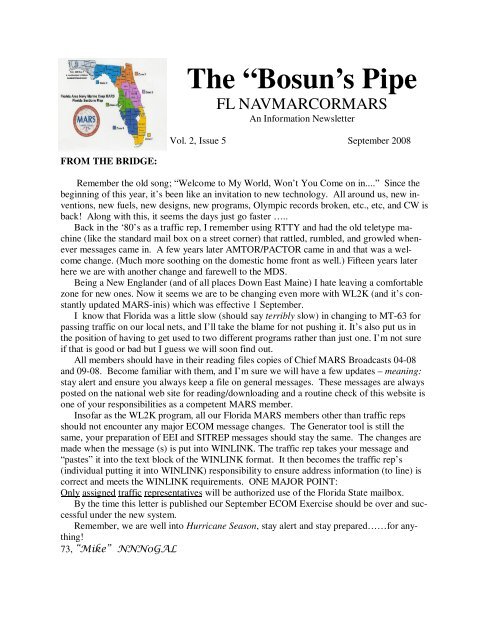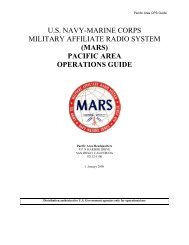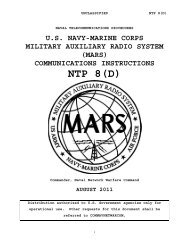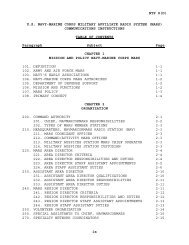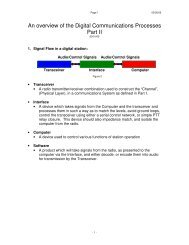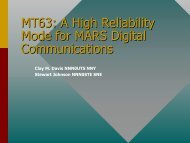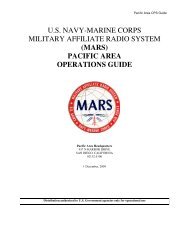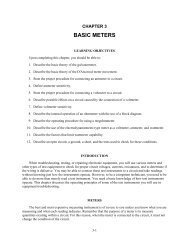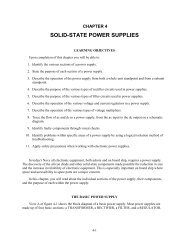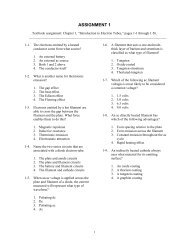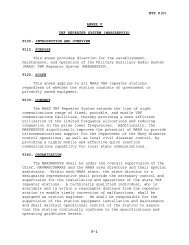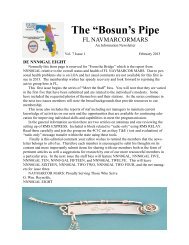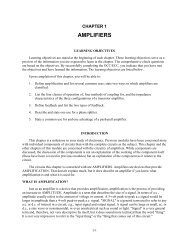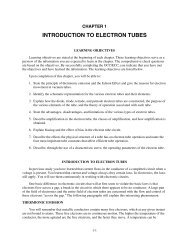The “Bosun's Pipe - Navy-Marine Corps MARS
The “Bosun's Pipe - Navy-Marine Corps MARS
The “Bosun's Pipe - Navy-Marine Corps MARS
You also want an ePaper? Increase the reach of your titles
YUMPU automatically turns print PDFs into web optimized ePapers that Google loves.
<strong>The</strong> “Bosun’s <strong>Pipe</strong>FL NAVMARCOR<strong>MARS</strong>An Information NewsletterVol. 2, Issue 5 September 2008FROM THE BRIDGE:Remember the old song; “Welcome to My World, Won’t You Come on in....” Since thebeginning of this year, it’s been like an invitation to new technology. All around us, new inventions,new fuels, new designs, new programs, Olympic records broken, etc., etc, and CW isback! Along with this, it seems the days just go faster …..Back in the ‘80’s as a traffic rep, I remember using RTTY and had the old teletype machine(like the standard mail box on a street corner) that rattled, rumbled, and growled whenevermessages came in. A few years later AMTOR/PACTOR came in and that was a welcomechange. (Much more soothing on the domestic home front as well.) Fifteen years laterhere we are with another change and farewell to the MDS.Being a New Englander (and of all places Down East Maine) I hate leaving a comfortablezone for new ones. Now it seems we are to be changing even more with WL2K (and it’s constantlyupdated <strong>MARS</strong>-inis) which was effective 1 September.I know that Florida was a little slow (should say terribly slow) in changing to MT-63 forpassing traffic on our local nets, and I’ll take the blame for not pushing it. It’s also put us inthe position of having to get used to two different programs rather than just one. I’m not sureif that is good or bad but I guess we will soon find out.All members should have in their reading files copies of Chief <strong>MARS</strong> Broadcasts 04-08and 09-08. Become familiar with them, and I’m sure we will have a few updates – meaning:stay alert and ensure you always keep a file on general messages. <strong>The</strong>se messages are alwaysposted on the national web site for reading/downloading and a routine check of this website isone of your responsibilities as a competent <strong>MARS</strong> member.Insofar as the WL2K program, all our Florida <strong>MARS</strong> members other than traffic repsshould not encounter any major ECOM message changes. <strong>The</strong> Generator tool is still thesame, your preparation of EEI and SITREP messages should stay the same. <strong>The</strong> changes aremade when the message (s) is put into WINLINK. <strong>The</strong> traffic rep takes your message and“pastes” it into the text block of the WINLINK format. It then becomes the traffic rep’s(individual putting it into WINLINK) responsibility to ensure address information (to line) iscorrect and meets the WINLINK requirements. ONE MAJOR POINT:Only assigned traffic representatives will be authorized use of the Florida State mailbox.By the time this letter is published our September ECOM Exercise should be over and successfulunder the new system.Remember, we are well into Hurricane Season, stay alert and stay prepared……for anything!73, “Mike” NNN0GAL
From the desk of NNN0GAL TWO:For this issue I am presenting the training questions and answers that I have been introducing on our nets. My goalis to encourage member participation, to stimulate interest and to present the ecom material in a manner that, hopefully,makes it easier to remember. I am trying an outline format this time.ECOM TRAINING/REVIEW QUESTIONS:1. What creates the need for emergency communications?a. Ans: An unexpected situation or disaster that affects an area or community which results in an overload oflocal relief and emergency services and requires backup communications.b. Is this emergency situation generally wide spread or localized?c. Ans: It is usually one that is wide spread, effecting at least a community or section of a community.d. What has to first take place before <strong>MARS</strong> becomes involved?e. Ans: A request needs to be received from a representative of the Department of the <strong>Navy</strong>, an elected or appointedofficial of civilian government or an employee or appointed volunteer of a disaster relief agency.f. Can <strong>MARS</strong> be used to support civil defense?Ans: yes but only when not superseded by needs of a higher authority.What is the order of priority for the use of <strong>MARS</strong> communications?a. Ans: <strong>Navy</strong> and <strong>Marine</strong> <strong>Corps</strong> communications have first choice.b. <strong>Navy</strong> and <strong>Marine</strong> <strong>Corps</strong> activities within for supporting the affected area.c. Agencies of the Federal government have next choice.d. Disaster relief agencies have next choice.e. Other agencies, organizations or groups as approved by the <strong>MARS</strong> area director then given a choice.f. Can individual members self activate to the scene of an accident, incident, disaster or emergency?g. Ans: No. Individuals are not authorized to self activate.h. Give an example of how an individual member can apprise members of the <strong>MARS</strong> chain of command concerningemergency or disasters.i. Ans: Through the use of EEI Reports and sending an e-mail to AAN3EEI in the case of an actual incidents ordisaster.j. How often do Sitreps need to be updated?k. Ans: within four hours.When is the only time an individual member can send a Sitrep directly up the chain of command?Ans: When physically situated at the scene of the incident and have more information than state director and herassistants would otherwise have, otherwise, sitreps are not to leave the state except by the state director or her assistants.What does Comcon III mean?Ans: An emergency or disaster situation that is expected to develop within forty-eight hours. Action required:Alert NAVMARCOR<strong>MARS</strong> stations to monitor primary frequencies to the extent feasible. Test emergencypower, locate essential items such as flashlights, ecom plan etc.What does Comcon II mean?Ans: an emergency or disaster situation is expected to develop within twenty-four hours. Action required:Effect all measures necessary to activate on short notice. Curtail routine as necessary forreadiness.12. What does Comcon I mean?Ans: An emergency or disaster situation is imminent. Action required: suspend all normal operations as warranted.Activate emergency networks and the emergency communications plan as necessary. Send an implementationmsg.What does Comcon 0 mean?Ans: An emergency or disaster situation exists. Action required: identical as for comcon one.14. What are the common National <strong>MARS</strong> frequencies?Ans: Primary is 7382.5 KHz and secondary is 14385 KHz and 4042.5 KHz. In an event of an emergencyall NAVMARCOR<strong>MARS</strong> stations are requested to guard these frequencies for command
and control instructions coming from the national level. <strong>The</strong>se frequencies are available for useby area, region and state ECOM operations if use not otherwise advised against by Chief,NAVMARCOR<strong>MARS</strong> or NNN0ASZ.15. Why is the use of the EEI generator recommended?Ans: Because it makes for an excellent training tool and helps ensure a correct actual incident report.16. When filling out an EEI Report if you really don’t have an answer for line 1B, 1C, 1D, 1E, and 1F, what wordingshould you use?Ans: Use the descriptive word ‘operational’, ‘unknown’ or ‘N/A’. Remember, always keep the reportshort and simple. Present the ‘big picture’ and avoid excessive local information.17. Is it ok to go into a lot of detail explaining the situation in an EEI Report?Ans: No – pay attention to making it brief and to the point. Avoid unnecessary words. Don’t useabbreviations that people at the National level won’t understand. When, for example, mentioningroad closures don’t list local streets. Use main arteries instead.18. Why is the source description so important in line 1G?a. Ans: To permit the recipient to be able to contact the source if necessary.b. If I have to prepare an EEI Report where do I find the addressees I need to use for it?c. Ans: One source is the FL ecom plan. Another is the Central Area Operations Guide’s (COAG) addresseematrix.d. When I am using the EEI Report generator for an actual incident do I also need to send out an e-mail toAAN3EEI?e. Ans: No. <strong>The</strong> generator sends one automatically.f. When would I “ZEN”?g. Ans: When putting the report on the WL2K you would place the ‘ZEN’ in front of each of the Florida addeesto prevent the system from sending it back to Florida for delivery. Florida addees are to get their copy directly ona Florida net and not through the WL2K system. <strong>The</strong> other time you would use ‘ZEN” is in the TO line toAAN3EEI when it is an actual incident and you have e-mailed him a copy.h. What is the e-mail address I use for sending to AAN3EEI?i. Ans: AAN3EEI@winlink.org.j. Once a state director has sent an implementation msg what is the time requirement for sending follow-up sitreps?k. Ans: Within four hours. <strong>The</strong> FROM line must clearly indicate who is sending out the sitrep, i.e., the state directoror the state director assistant. If an individual state member is sending out a sitrep the state director or assistantstill must submit a sitrep. Unless at the actual scene of an incident members are requested to send their sitrepseither to the state director or her ECOM assistant and not up the chain of command.l. What are the minimum report requirements for any ecom event and to receive credit for the exercise? Howare these msgs to be sent?m. Ans: Implementation report msg, one or more EEI Reports, one or more sitrep(s), operations report msg, afteraction rpt, and a notification msg if an exercise. All msgs must be sent using the WL2K at this time.n. According to AS4 TWO what are some of the more common mistakes made with EEI Reports?Ans: Line 1 (one) may be missing the word ‘REF’ or even the ‘/state’. Also line 1A doesn’t contain all of thewhat-where-when information, such as, city/county/state and time in ZULU. Line 1G may also be incomplete, thatis, time and location of the listed radio/TV station source hasn’t been included. Lastly, the report is too long andwordy and needs to be made shorter, more concise and briefer. This can be done by using the words ‘operational’,‘unknown’ and ‘N/A’ used in lines 1 B, 1C, 1D, 1E and 1F.
A word from NNN0GAL FOUR;I believe that Florida <strong>Navy</strong> <strong>Marine</strong> <strong>Corps</strong> <strong>MARS</strong> is, without a doubt, the most efficient,best trained, most adjusted to the SOP and most participated <strong>MARS</strong> group of region four. It is apleasure to be the training officer of the state that needs the least training, and for that I thankall the members for your hard work. But, there are always areas of improvement. One area thatI would like to briefly expand on is NECOS duties.<strong>The</strong> NECOS is by far, one of the most important roles and positions in <strong>Navy</strong> Mars.Unlike a fixed staff position, the NECOS duties are shared among us all. <strong>The</strong> NECOS assignmentis like an orchestra conductor, the orchestra is only as good as the conductor. Familiarityand confidence in this position assures an efficient, seamless net, whether it is a traffic net or anECOM net. <strong>The</strong> potential of any member having to assume net control is always a possibility,therefore the importance of practicing the job on a continual basis.<strong>The</strong> alternate net control station (ALTNECOS) is just as important as the NECOS. It isimperative that every net not only have a NECOS, but an alternate as well. Our net managersgo to a lot of trouble to make schedules that will fit around everyone’s lives. It is important thatthe members give the net managers all the information needed to make a comprehensive schedulethat is reliable and can be met by all the members. <strong>The</strong>re are always circumstances beyondour control that takes us away from commitments previously made, but we should remain asdiligent as possible to meet our <strong>MARS</strong> responsibilities. Remember, we are all expected to actas NECOS on a regular basis. I am sure that there are only few exceptions.I recommend all members read NTP 8(D) 502. This is a brief outline of NECOS dutiesand responsibilities. Until next time, practice makes perfect!Bud CourtneyNNN0VDGNNN0GAL FOUREditorial Notes (or Ramblings)Antennas - In the newsletter we have been featuring in each issue an article on an antennathat is or has been used by the <strong>MARS</strong> community. I assume that each of you members/readers recognize that any antenna that you decide to try or use for your operations is a compromise.It has to fit your location. It has to meet your operating habits. It has to be withinyour budget. With this mind there still a couple more antennas that will be presented in futureissues including “another no tune antenna” as well as an antenna designed for FL net operations.If you, a member have a favorite antenna that should considered for inclusion, passthe word along to the editor. This month’s antenna was suggested by NNN0ABA, David.Sound Card Digital Operations - It is most important that members make every effort todevelop the ability to use the sound card modes in their station. With FL moving to MT-63 asthe primary mode for SCD traffic on our nets, all members should get their station computerset up with an interface of their choice and the appropriate software to use these modes. Itshould be noted that a second ARQ sound card mode (WINMOR) is scheduled for presentationat the TARA seminar later this month. It is reported that this mode will be compatiblewith WL2K. This station knows nothing more at this time but will be following the announcementsclosely. <strong>The</strong> other soundcard application that provides ARQ is the <strong>MARS</strong>-ALE
(closely related to PCALE) which is being used by NNN0ZTT, NNN0TFH, and NNN0TAKon an experimental basis in FL. NNN0TAK is sounding and monitoring the Tri-Services ALEfrequencies nearly 27/7. <strong>The</strong>re will be an article discussing this application more thoroughlyin the near future. <strong>The</strong> application does have a reasonably steep learning curve in getting it setup properly but does provide a number interesting possibilities.WL2K - At the time of writing these notes, WL2K has been the official system for movingrecord traffic in NAVMARCOR <strong>MARS</strong> since 1 September. So far I know of any glitchesin the traffic for FL. Your traffic reps have been getting the traffic on their assigned days andhave been bringing it to the nets. In FL we still need additional stations that can access thesystem using Pactor to back up these people. If the WINMOR application is successful evaluatedand becomes a tool for our use, it will be possible for members to become available astraffic reps without the necessary purchase of a TNC and/or upgrading one of the older availableunits at a hamfest.CW - Since the announcement by NNN0ASA that NAVMARCOR <strong>MARS</strong> could makeuse of the “CW” mode in times of need to handle emergency traffic, the 4C1C net has met onSaturdays at 1500 local time. <strong>The</strong>re have been from 4 to 8 hardy souls meeting to improvetheir “CW” skills. At the time of preparing these notes, this station has faithfully inflicted mylack of skill on the net. My ability to copy the code has improved to where 10 wpm is nownearly perfect copy but the sending skills leave a lot to be desired. Using a straight key (myantique “J-38” key) is at best marginal. Using a paddle and the built-in keyer the effort ispassable but still needs a lot of practice. With the computer and MIXW I can send good cleancode at whatever speed you can copy. When th net was first starting there was difficulty gettingall stations on or near the same frequency. <strong>The</strong>re is still some variation but there is definiteimprovement.Are you on frequency when transmitting? With the advent of the modern transceiverand the surface mount construction of the components it has become the normal practice forthe user to accept the manufacturer specifications regarding frequency stability and precision.With the modern transceiver the operator can not verify the accuracy of the transmitted frequencywithout additional equipment which has been calibrated to the required standards forour operations. Paragraphs B520, B521, and B522 of ANNEX B, NTP-8(D) (DRAFT) indicatethe tolerances required for NAVMARCOR <strong>MARS</strong> operations. Paragraph B521 specificallystates that for both SSB and SCD operations that stations will be +/- 20 Hz of the assignednet frequency. All of the modern transceivers after the prescribed warm up timeachieve the stability requirement of maintaining a receiving frequency as indicated on the dialindicator. <strong>The</strong> frequency read on the dial may or may not be within the tolerance required.<strong>The</strong> precision is dependant of the calibration of the reference oscillator(s) that are in the localoscillator chain for the double and triple conversion chains that are used in modern transceivers.Each oscillator will have its own inherent error and the total error in the chain is cumulative.This is also true for the transmitting chain of oscillators, although in the modern transceiverwill use oscillator elements that are common to both RX & TX. It is also a known thatas components age they will change value. <strong>The</strong>refore the member needs to be not only awareof this but needs to verify the precision periodically. <strong>The</strong> variation, particularly in the transmitis most noticeable in SCD operations and detectable in either the waterfall or spectrum displayedon the screen. Plus/ minus 20Hz probably will not be detectable by ear only but maybe sufficient to affect the copying of some digital modes. This topic will receive a morethrough treatment in a future issue.De NNN0TAk
MT-63Ref (A): FL BCST 10.08(B): FL NewslettersOn 30 July 2008, Ref (A) was promulgated stating that effective 15 August 2008MT-63 would become the primary mode for SCD traffic distribution on the FLNAVMARCOR<strong>MARS</strong> nets. This BCST makes the process of connecting your stationcomputer through a sound card interface to your station transceiver for copyingand sending SCD traffic in this mode a priority for all members.MT-63 Technical DescriptionMT63 is intended for conversational use between one of more Amateur Radiostations, providing good performance under poor conditions, and consequently utilizesFEC rather than ARQ error correction processes. <strong>The</strong> MT63 modem, constructedaround a high speed DSP processor, either in a dedicated external DSP unitlike the Motorola EVM, or in PC software using the PC sound card, transmits 64tones spaced 15.625 Hz apart, in the 1 kHz bandwidth. <strong>The</strong> base-band signal occupiesfrom 500 Hz to 1500 Hz. All 64 tones are differential bipolar phase shift keyedat 10 baud. Since the Walsh FEC code is 64 bit, the character rate is the same as thesymbol rate, so the throughput with FEC is ten 7-bit ASCII characters/sec (about100 WPM). <strong>The</strong> following diagram (courtesy of Eduardo EA2BAJ) illustrates the 1kHz wide MT63 spectrum:MT63 Power Spectrum<strong>The</strong>re are two other bandwidths that can be used, 500 Hz, and 2 kHz, where thetone spacing and baud rate are halved or doubled, and the throughput halves or doublesrespectively. Unless otherwise indicated, this description is of the default 1 kHzversion.In addition, an optional doubling of the interleave period improves the temporal
esistance (e.g. to burst noise) at the expense of increased time delay through the encoder andBandwidth Audio Range Symbol Rate Character Rate Interleave500 Hz 500—1000 Hz 5 baud 5 char/sec 6.4 o4 12.8 sec1000 Hz 500 – 1500 Hz 10 baud 10 char/sec 3.2 0r 6.4 sec2000 Hz 500 - 2500 Hz 20 baud 20 char/sec 1.6 or 3.2 sec<strong>The</strong> user data from keyboard or file, (the data code is 7-bit ASCII), is further encoded into 64bits using a Walsh/Hadamard function to provide a highly robust FEC technique with highredundancy. <strong>The</strong> Walsh function ensures that up to 16 of the 64 bits can be corrupted, yet decodingwill still produce an unambiguous result.<strong>The</strong> MT63 signal is spread both in the time domain (temporally) and the frequency domain(spectrally). To ensure that noise bursts and other time domain interference artifactshave minimal effect, each encoded character is spread over 32 sequential symbols (3.2 sec).To ensure that frequency domain effects, such as selective fading and carrier interference haveminimal effect, the character is also spread spectrally by using all the tones across the width ofthe transmission.Why use MT-63 on FL NETS?1. “Reliability, Accuracy, Speed” are the three bywords when handling traffic on <strong>MARS</strong>nets. <strong>The</strong> first two are not to be sacrificed in achieving the third. <strong>The</strong> forward error correctionof AMTOR-FEC or PACTOR-FEC are not as robust as the error correction found in the MT-63 application providing a greater probability for accuracy using the MT-63.2. MT-63 does not require an expensive TNC to assure both good reception and transmissionof long SCD messages. It makes use of the sound card technology already in your stationcomputer.3. <strong>The</strong>re are three readily available software applications for the member to use at no costor a nominal cost to the member.4. More of the states in Region FOUR are using or are moving to this mode for generaltraffic distribution.What do you need to have to use MT-63?1. Computer w/sound card, computer speakers, computer microphone and transceiver arethe absolute minimum hardware for receiving and transmitting MT-63. <strong>The</strong> quality and easeof using MT-63 is enhanced by the addition of an interface placed between the computer andthe transceiver requiring available COM port(s) for keying and rig control. You will also needa software application selected from the three mentioned in the previous section.2. <strong>The</strong> selected software will have to be installed on your computer and configured foruse on the nets (Note: any one of the three may be used with the minimum setup or with anenhanced setup using a hardware interface}
Available software ApplicationsIZ8BLY MT63 Terminal – This application is a freeware application available fordownload from the internet. It is a single purpose application. It works very well and is easy toconfigure. If using with an interface the user must have a com port (COM1, COM2, COM3, orCOM4) available for keying port.MultiPSK - This application is a multi-mode software package and is also available in botha freeware version and a shareware version. It is also available for download from the internet.Since it is a multi-mode application, it is more difficult to configure. It also works well and offersthe member other sound card modes to evaluate (Note: the difference between the sharewareversion and the freeware version is that there are added features for the user; i.e. an audiospectrum oscilloscope, etc., none of which affect the use of the different modes.}MIXW – This application is also a multimode application. It is shareware but there is trialversion download for the user (time period limited). This software also requires more carefulconfiguration. Although this application requires the shareware license for continued use, it isnominal and the application has the advantage of adding additional modes, Olivia, as they becomeavailable. <strong>The</strong> application may also be configured to be used as the terminal program tobe used with a TNC without affecting the sound card modes. It also works well for our use andwhen setup properly will send AMFEC readable by a TNC.Setup:Without InterfaceReceivingInstall the software of your choice. Configure the software to key VOX so that it is not lookingfor a port. Insert the computer microphone into the MIC IN jack on the computer. Place themicrophone near the transceiver speaker. Using MIXW or MultiPSK select the mode MT63.When you hear (a low growl) you should a broad signal in the waterfall and the applicationshould decode the signal and print on your screen. You can now copy the signals. (Note: thiswill work with all three applications)TransmittingFor testing purposes, with the transceiver off or in receive USB and VOX off, place the softwarein TX using the function in the program. From the computer speakers you should hear theMT63 audio. Type some words into the “transmit data box” (usually the lower box of the dividedwindow) and observe the words echoed in the receive area. To transmit live, you willhave to key the microphone and place it in front of the computer speaker and key the software.<strong>The</strong> XCVR microphone will pickup the audio and modulate the XCVR sending the signal to thenet. This is awkward as the microphone must be keyed during the entire transmission of thedata. Using a desk mike w/ a key lock makes it easier although a rubber bank that can be easilyslid up on a handheld mike works also. (Note: check w/ NNN0IBM as she has used this techniqueon the 4C1B net on THURS)After experiment in this manner, it is recommended that you either build a simple interfaceor purchase a kit and build on or purchase a commercial interface.With InterfaceAn interface is placed between the computer and the transceiver. An interface relieves theoperator of the task of manipulating two microphones and the awkwardness of remembering
several steps in the RX/TX process. It also isolates the computer and transceiver reducing thepossibility of computer generated noise getting into the transmitted data. It also provides thekeying function through a serial port. <strong>The</strong> Alabama NAVMARCOR <strong>MARS</strong> web site is a goodreference for sound card application information. <strong>The</strong> WM2U site (www.qsl.net/wm2u) is alsoan excellent reference site for information on sound card modes. <strong>The</strong> software mentioned earliercan be downloaded through these sites.<strong>The</strong> selection of an interface that a person uses in his/her station should be compatible with thetype of operations in which the member participates; i.e. normal net operations, traffic rep duties,and equipment that the member has in his station. A quick search on the internet for“sound card interface” produced nearly 20000 hits. <strong>The</strong> query produced a number of circuitdiagrams of simple devices, a large number of kits for the user to build and customize his owninterface, and the full range of commercially constructed units ranging from a few tens of dollarsto those with many bells and whistles costing several hundred dollars. <strong>The</strong> question “Is anyone particular device best for <strong>MARS</strong> and/or Amateur operations?” is difficult to answer. <strong>The</strong>writer is a firm believer of the KISS principle. Perhaps the best way to illustrate this is to outlinethe thinking process that was used in selecting the interface that is in current use in thewriter’s station. <strong>The</strong> primary station is made up of a 100 watt transceiver, antenna tuner, TNC,sound card interface, key/ paddle, CAT interface, and computer. This equipment array is usedboth for <strong>MARS</strong> operations and amateur operations. During <strong>MARS</strong> operations I may use up tofour computer applications simultaneously during a single net. While at other times when pollingthe WL2K mailbox as traffic rep only a single application may be used. <strong>The</strong>refore thesound card interface and its operation must not interfere with the other operations. In generalthe sound card application prefers unprocessed analog data for its input and the data from thesound card should not be processed prior to modulating the RF signal in the transceiver. Havingthis information it is necessary to get out the manuals and determine where to get the necessarysignals and where the necessary inputs will be going to accomplish our requirements. Afterreading carefully the writer found that unprocessed audio at a constant level is available atthe accessory port on both the Kenwood and ICOM transceivers. It was decided that this portwould be used for the sound card interface and that a mike/TNC switch would be used for TNCoperations allowing some audio processing for both voice operations and TNC mailbox duties.<strong>The</strong>refore the writer is using a simple interface consisting of two 1:1 audio xfmrs for isolation,two 5 kohm potentiometers to adjust audio level to and from the sound card, two NPN switchingtransistors for keying the transceiver from the serial port. If I were replacing this interface Iwould use two optical isolators in place of the NPN xstrs. This interface is also available as akit and as commercially built unit. This interface has worked satisfactorily for all sound cardmodes including <strong>MARS</strong>-ALE. (<strong>The</strong> circuit for this interface was published in an earlier newsletter)<strong>The</strong> above section is not designed to detract from any of the available interfaces. <strong>The</strong> memberneeds to make the selection to match his/her station operations. I personally set up andtested sever of the units that are on the market for amateur radio friends and have found themall satisfactory when setup and operated within their design parameters. Most problems thatarise in setting up the sound card/ interface and the application are usually resolved with appropriateadjustment of the input and output volumes of both the computer and the interface. Keyingproblems are usually related to port settings and/or the pins selected in the application forthat function. Other than this general advice each problem needs to be assessed individually.
Cobra Antenna<strong>The</strong> original Cobra antenna designed by W4JOH can be built as an all band hf antennacovering either 160 thru 10 meters or 80 thru 10 meters and is built using standardinsulated wire of about 14 gauge and fed with 450 ohm ladder line down to the shackinto a tuner. It got it'sname from the S shaped configuration of it's multi-conductor elements. It performs onit's primary and harmonic operating frequencies as a standard ladder-line fed doublet.<strong>The</strong> close spaced wire elements on each leg introduces two added resonantresponses BELOW the antenna's fundamental operating frequency.<strong>The</strong> 140 foot version (80 meters) in picture also resonates at about 2.8mhz and alsoon 160 meters. A standard dipole at 1.9mhz is about 246 feet total compared to 140feet in the Cobra!. This fact alone makes this an ideal antenna for restricted space onthe TOP BAND! <strong>The</strong> half sized version, 73 foot (40 meter) also covers 60 and 75meters!All band operation has been reported in the original article to be excellent! (With atuner of course). This antenna design extends the coverage compared to a G5RV bothinbands and performance. On its primary and harmonic operating frequencies, testsshow no discernible difference in signal strength between a Cobra and a regular fullsizeddoublet or dipole. On its sub-bands bands where the Cobra is physically "short",efficiencyis somewhat lower than for a full-sized dipole.If you do the math, you will see that there is actually about 420 feet total wire acrossthe top of the antenna on the 80 meter version, (210 feet per side), and about half thaton the 40 meter version. <strong>The</strong> flattop and lead-in length were strictly determined by thephysical limitations of the antenna farm and this project is a result of those limitationsand the idea of compressing or folding the wire back on itself to fit the antenna farm.(No formulas were given in the article), but they seem to be this:1/2 of total known length / frequency = multiplier for formula below:
210 / 3.750 (band center) = 56 (unknown multiplier)So 56 X 3.750mhz (band center) = 210 feet per side. Which is exactlywhat he used per side.Editor's note: "This formula is mathematically correct in solving for the unknownassuming the lowest band center frequency was used, but may not be what was usedin the original antenna experimentation if any formulas were used at all! <strong>The</strong> originalauthor, W4JOH, may havearrived at the lengths strictly by experimentation and found them to workwell."....N4UJWKeep in mind that there are actually 3 conductors connected in series per side andfolded back on each other..... or another way of saying this is that there is onecontinuous length of 210 feet per side in the 80 meter version connected to one side ofthe ladder line and the same onthe other half. Because the Cobra antenna is a balanced load, it is recommended toLooking Ahead To <strong>The</strong> Next Issue -In addition to the usual staff reports, the next issue will include pictures and summary ofthe Region Four conference. <strong>The</strong> antenna to be featured next month will be the Ten-Tec notuneloaded dipole antenna. This antenna is no longer commercially available but may be fabricatedeasily using the instructions in the article. All members are requested to send suggestionsfor articles to the editor. Remember this is your newsletter and it supposed to assist youas a <strong>MARS</strong> operator member.


